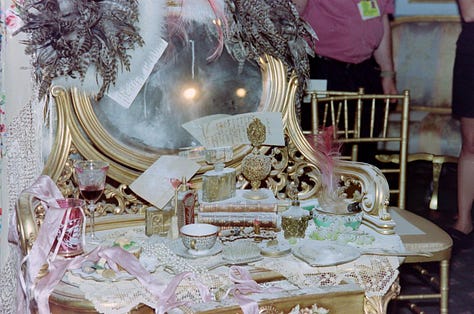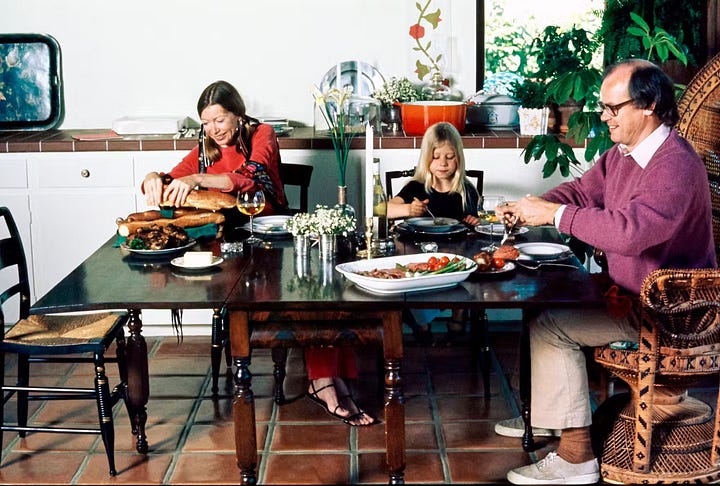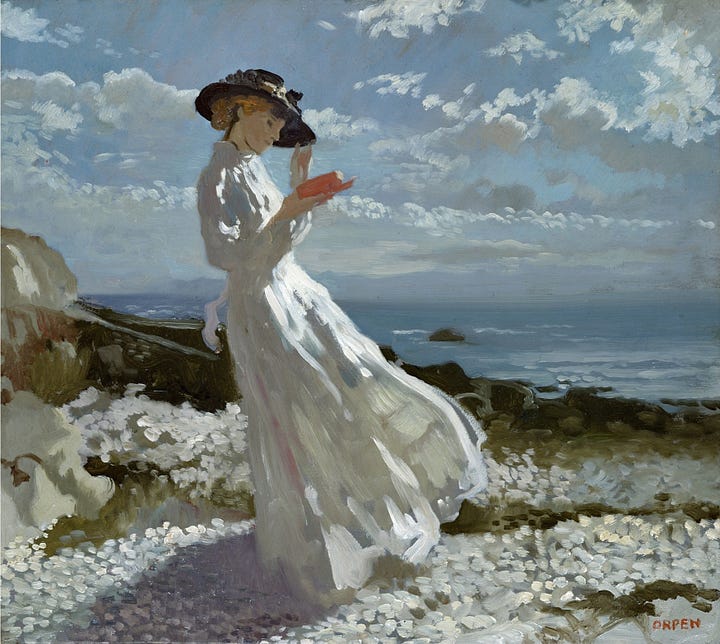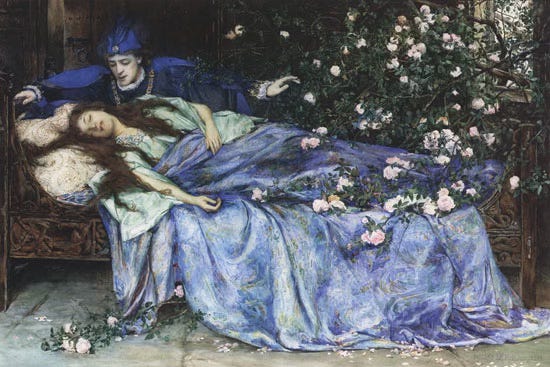Friday Frivolity no. 20: Once Upon a Dream
Sleeping Beauty, Princess Syndrome, and How Girlhood Failed Me
This is an installment in the section Friday Frivolity. Every Friday, you’ll get a short essay, plus a moodboard, 3 things I’m currently in love with, words of wisdom from what I’ve been reading lately, a little shimmer of poetry, a “beauty tip,” and a question to spark thought.
—
Once Upon a Dream
Something reminded me of Sleeping Beauty, the 1959 Disney film, the other day, so I went back to watch it. Until middle school, basically the only movies I was allowed to watch were Disney movies, and we mostly had the princess ones—I guess I mostly liked the princess ones—so I would watch them again and again and again. Sleeping Beauty was my favorite until, as a teenager, I received the message that princesses should be saving themselves, getting themselves down from the tower, themselves doing battle with dragons, themselves outwitting the witch, themselves foiling the evil queen, and so Sleeping Beauty drifted away, sinking down to the sea floor of my self, where, no doubt, unbeknownst to me, it continued to let out its vapors, exhaled its vague odor, from some substratum of my soul.
I guess I spent most of my teenage years sleeping. I don’t mean that literally, because I pulled more all-nighters than my (comparatively) elderly, tired self can now fathom, but in that I was always in my own inner world of daydreams or delusions, reading, writing, musing, poeticizing, scrolling the Internet, and what they’ve since coined “bedrotting.” It was a passive existence. I think I was depressed. I lived as though in a tower: I had no siblings, I had no friends I was really close to, I had no faith in what the future would bring me, and I was content to drift, content to be sheltered, content to sleep “forever in a moon-green pool.”
Then college came, and I grew out of Sylvia Plath and the Virgin Suicides, I grew out of circling the drain of myself, I learned to take my happiness into my own hands, I walked, breathed the fresh air, studied, pushed and applied myself, ate real meals, and took real joy in everything that life had to offer. Yet she was still there, always, that Sleeping Beauty, eyes closed, a smile on her rose-red lips, even then seeping out her fairy-tale magic into the conflux of my personality. Even now I relate to the girls who have grown tired of girlbossing and want to girlrot, I can see myself as one of the girls who’d rather do “girl math” than be in STEM, I sympathize with “girl dinners,” which I ate regularly at a time in my life when I had no care for health, no knowledge of nutrition, and, like the fairy Fauna, no cooking skills.
In recent years, there’s been an uptick in girls exhibiting what one might call “princess syndrome.” They want to be taken care of, they associate themselves with bunnies and lambs, with big-eyed does and little pink bows, they aspire to be the soft-life tradwife, they’d like nothing better than to sleep and dream while the prince fends off the dragon and defeats evil and wakes one up into a better, easier world with nothing more demanding than true love’s kiss. Little do they realize that the women—not girls—who actually get the wealthy men are often hard-edged and ambitious, equally if not more business-minded than their spouses. Rarely will it be that someone will simply drop out of the sky and reward you for your goodness and purity of heart. Ah, if only. If only we could magic rocks into bubbles and broken bridges into rainbows and “the slings and arrows of outrageous fortune” into a shower of harmless falling blossoms. If only!
I think girlhood failed me. Either it brought me a vision of the feminine that was all passivity, all roses and romanticized rot, or it told me that the only other option was to reject that femininity altogether, try to make myself good at or passionate about the things that didn’t come naturally to me, eschew my desire for romantic love, instinctive feeling for family over office life, or attraction to what was masculine in men, and become hyperindependent and thus alone. I think I probably should have been exposed to bugs and dirt, I think I should have been given more responsibility, I think I should have been less sheltered, I think I should have learned a little self-reliance, and yet I like the person I am today, I wouldn’t want to be anybody else. Now that I am no longer girl but woman, no longer child but—thank goodness—adult, I have the power to correct my faults and try to synthesize the disparate pieces of myself into a common whole.
Ever since I was a child, my favorite activity was dreaming, and my favorite thing to dream about was the people I loved. Sleeping Beauty, too, dreamt “of true love / in slumber repose.” My earliest memories are of being in the basement of our house, imagining that I was in a dark forest and a witch was chasing me, and then I would dash up four flights of stairs, fling myself onto my bed, pull the covers over my head, and, calm then, think of my parents and how much I loved them and fall asleep with a smile on my lips.
It is all very well to dream. Every action needs the backing of some motivation, every “how” and “when” and “what” and “where” a “why,” every doing a designing. But even Sleeping Beauty ventured out into the woods one day, with a mission to collect some berries, and sang a little song, and danced a little dance, and spoke and joked with her fellow creatures, and gazed out upon the world, without which she would never have met her true love, not in any dream, assuredly, but in reality.
Mood Board of the Week
(left to right, top to bottom)
Ling Tan for John Galliano Fall 1998 Fur Collection: In 1998, designer John Galliano teamed up with Stallion Furs at the Metropolitan Club to present this “Casanova”-inspired collection: big fur coats, opulent jewelry, dramatic silhouettes, long tapers of candles, banquets of fake fruits, rococo romanticism, endless glamor. I like the way this image mirrors the last, two women, almost a century apart, looking into their handheld mirrors.



John Galliano Fall 1998 Fur Collection Photograph by jurist--academia on Tumblr: Anything shot on film charms me but old buildings the most, especially if there is something solitary about them, or tucked-away and hidden, reminiscent of a long-forgotten afternoon.
Joel Meyerowitz, Dinner Table, Provincetown, Massachusetts (1983): Born in 1938, Joel Meyerowitz quit his job as an art director at an advertising agency in 1962 to take up a career as a photographer, first documenting the streets of New York City. He advocated for the use of color film when only black-and-white was considered proper for “serious” photography and used it to capture street scenes, portraits, buildings, nature, and still lifes. I like the composition of this one, the subtlety of the colors, the mystery of the fallen pink petals, the array of cups and half-filled wine glasses and spoons and a single solitary teapot, obviously no dinner on the “dinner table,” simultaneously “as-is” and contrived, as the best still lifes are. In another photograph, taken of the same table from a different angle, titled “Early morning still life,” it becomes easy to imagine a late dinner, ending with an overflow of wine and conversation, abandoned by sleepy guests, the forlorn table waking up to the calm of the ocean in the early hours.


Joel Meyerowitz, Dinner Table, Provincetown, Massachusetts (1983) and Early morning still life (1983), via Artsy and Mount Holyoke College Art Museum Isabelle Adjani’s bedroom in 1995: The bedroom of actress Isabelle Adjani is thankfully a far cry from the one she inhabits in her most famous role as the heroine of Andrzej Żuławski’s horror movie Possession (1981). Now I, too, want a frilly heart-shaped pillow and a little blue lamp and a cozy bed nook.
Linda Evangelista by Nick Knight for Dior Fall 1997: Nick Knight is one of my favorite fashion photographers; I love the experimentation of his work, his embrace of new technologies, and most of all his openness in revealing his creative process “from conception to completion” on his website SHOWstudio, where he frequently invites others—supermodels, stylists, make-up artists, hairdressers, fashion designers—to do the same. Here I love the dreaminess of the picture, how it looks almost drawn or painted, pink and serene.


Linda Evangelista by Nick Knight for Dior Fall 1997 Jean Cocteau holding up two of his paintings outside of La Villa Santo-Sospir: Artist, playwright, novelist, designer, and film director Jean Cocteau decorated and drew on this villa, owned by socialite Francile Weisweiller, and then made a 35-minute documentary about it in 1952. You can watch the documentary here—it’s very joyful and playful and has the look and feel of a home movie.
Joan Didion’s belongs, photographed by Stair Galleries: Joan Didion is a writer, but she has achieved what most writers have not: style. Not prose-style but style-style: the long-lingering cool of posing in a floor-length dress in black-and-white, leaning against a Corvette, a cigarette between her fingers, indelibly etched into the American consciousness. She comes from the West where it is possible to be cool; no recluse Dickinson, depressive Woolf, or unmarried Austen or Brontë, she allowed Vogue a look into her home in 1972, resulting in bright, cheerful images of family life, lots of sunlight, lots of colors, lots of platters and vases and pots and baskets and jars brimmed with the California bounty. It’s sad to think of someone’s—anyone’s—most beloved belongs picked through and photographed and pulled apart and sold piecemeal at auction, but one likes to think these items have found new homes in which to be cherished.


Joan Didion by Julian Wasser for Time in 1968 / Joan Didion at home by Henry Clarke for Vogue in 1972 Lillian Pitt, Pipestone Secrets (2013): Lillian Pitt is a Native American artist who grew up on the Warm Springs Reservation in Oregon and later moved to Portland. She started taking art classes in the 1970s when back problems put her hairdressing career on pause, and art became her vocation. Since then, she has produced sculptures, masks, works in glass and bronze, jewelry, and her distinctive petroglyphs, which draw on symbols etched into rock thousands of years ago by her ancestors along the Columbia River. I came across one of her petroglyphs at the MFA in Boston and was drawn to its distinctive shapes and its union of ancient and modern.
William Orpen, The Eastern Gown (1906): William Orpen (1878–1931) was an Irish artist who documented Edwardian society, becoming the most famous and commercially successful artist in Britain by the onset of WWI. The war turned him into a documenter of death and horror for a time, but he returned to society and commercial success soon after its end. I like the insouciance of his self-portraits and the ethereality of his women, like this one, Flossie Burnett, draped in a long transparent gown on a couch of strewn fabrics, her pearls on, her hair undone, contemplating—perhaps scrutinizing—herself in a mirror.


William Orpen, The Mirror (1900) and Grace reading at Howth Bay (ca. 1900s), from Wikimedia Commons
3 Things I’m in Love With This Week
Dead Souls by Nikolai Gogol: This book is hilarious. I’d forgotten how much I love Gogol. It was my father who introduced me to his work when I was an adolescent, and I read “The Overcoat” (out of which we have all, to quote Eugène-Melchior de Vogüé, come out of) again and again, before proceeding to devour the rest of Gogol’s short stories—“The Nose,” “The Tale of How Ivan Ivanovich Quarreled with Ivan Nikiforovich,” etc. Dead Souls, however, despite the fact that my father and I often read the same books together and then liked to go over them afterwards, became one of those low-priority to-do list items that get pushed further and further down, until at last ten years have passed and your father is dead.
Dead Souls centers around a strange antihero, Pavel Ivanovich Chichikov, whose clever scheme to get rich quick involves acquiring from landowners dead serfs (the titular “souls”) whose deaths are not yet registered with the government. The landowners will no longer have to pay taxes on these dead souls, Chichikov can use the dead souls as collateral to buy an estate, and everyone wins. But the landowners, with all their eccentricities and peculiarities, prove difficult to deal with, and of all the dead souls, it is his own that Chichikov must most pay heed to.
“The New Business of Breakups” by Jennifer Wilson in The New Yorker: The business of heartbreak seems a slimy one: after all, you are profiting off the misery and sadness of others. But in this article, in which Wilson goes from heartbreak specialist to heartbreak specialist, she writes that nearly all of them “had the same origin story”: their own “earth-shattering” heartbreak. The stories of heartbreak—mostly breakups—strewn across this story touched me, as did the sometimes hokey, sometimes cheesy, mostly sincere efforts marshaled in the service of mending those broken hearts. It’s when we lose one another that we see just how attached we really are.
Car with stained glass window by MrsZero07 on Reddit: No joke, I would kill to have a car with a stained glass window like this. I’d outfit it with chandeliers, like this other car, and then I might actually start to look forward to driving, instead of avoiding it like the plague.


by MrsZero07 on Reddit / from r/whatisthiscar
Words of Wisdom
Should we look at the spring blossoms only in full flower, or the moon only when cloudless and clear? To long for the moon with the rain before you, or to lie curtained in your room while the spring passes unseen, is yet more poignant and deeply moving. A branch of blossoms on the verge of opening, a garden strewn with fading petals, have more to please the eye….
In all things, the beginning and end are the most engaging. Does the love of man and woman suggest only their embraces? No, the sorrow of lovers parted before they met, laments over promises betrayed, long lonely nights spent sleepless until dawn, pining thoughts for one in some far place, a woman left sighing over past love in her tumbledown abode—it is these, surely, that embody the romance of love.
Rather than gazing on a clear full moon that shines over a thousand leagues, it is infinitely more moving to see the moon near dawn and after long anticipation, tinged with most beautiful palest blue, a moon glimpsed among cedar branches deep in the mountains, its light now hidden again by the gathering clouds of an autumn shower. The moist glint of moonlight on the glossy leaves of the forest shii oak or the white oak pierces the heart, and makes you yearn for the distant capital and a friend of true sensibility to share the moment with you.
Are blossoms and the moon merely things to be gazed at with the eye? No, it brings more contentment and delight to stay inside the house in spring and, there in your bedroom, let your heart go out to the unseen moonlit night.
–Yoshida Kenko, Essays in Idleness, translated by Meredith McKinney
This translation of Kenko’s Essays in Idleness was accompanied by Chomei’s much shorter Hojoki, both works from the Kamakura period of Japanese history (1185-1333), both works written by men who took Buddhist vows and turned their backs on the world. Essays in Idleness, nevertheless, is full of wisdom for those of us still attached to the world, and it’s amazing how true Kenko’s words ring under vastly different circumstances. Here I have quoted one of my favorite passages from the book for the beauty of its descriptions and its images of moon and blossoms.
Poetry Corner
Fairy-tale Logic
Fairy tales are fully of impossible tasks: Gather the chin hairs of a man-eating goat, Or cross a sulphuric lake in a leaky boat, Select the prince from a row of identical masks, Tiptoe up to a dragon where it basks And snatch its bone; count dust specks, mote by mote, Or learn the phone directory by rote. Always it’s impossible what someone asks— You have to fight magic with magic. You have to believe That you have something impossible up your sleeve, The language of snakes, perhaps, an invisible cloak, An army of ants at your beck, or a lethal joke, The will to do whatever must be done: Marry a monster. Hand over your firstborn son.
–A.E. Stallings
A.E. Stallings is one of my favorite contemporary poets for the way that she imparts a freshness and wit to the “stuffy” formal schemes most poets have long abandoned (I’ve written before about my own ambivalence towards free verse), drawing on her study of ancient writers. This poem, which appeared in the March 2010 issue of Poetry, is one I return to every now and again, for its reminder that fairy tales aren’t always what they seem, both in the tales themselves and, of course, most terrifyingly, in real life.
Beauty Tip
Spend a few moments to think about who you want to be in the upcoming year. Don’t limit yourself—allow yourself the indulgence of dreaming fully. Then take the first smallest actionable step towards that right now.
Lingering Question
What do you need to be more excited about in your life?
Dear Readers, I felt a bit uncomfortable writing this post, since the “girlhood essay” is so derided now on Substack anyway, and since I never thought I’d have much to say on the subject in the first place, but, well, you can’t always control where your creative instincts go. Anyway, I hope you enjoyed reading—please like this post if you did, share with a friend, and leave a comment because I always love hearing your thoughts!









Well written and thought provoking Ramya! I want to run and share your essay with all the little girls who are watching Disney princess movies. Although those movies have tried to change the image Of an ‘ideal girl’, still the image of ‘sleeping beauty’ resonates. It is unfortunate that we had to resort to imaginary often banal movie characters to develop our childhood.
I am deeply saddened to learn you could not ‘ , “became one of those low-priority to-list items that get pushed further and further down, until at last ten years have passed and your father is dead”. Words cannot describe. But you perhaps have your mother to share and read together! Perhaps you may cherish that! Never know what may happen. Looking forward to your next ‘Friday Frivolity’
Very good! I appreciate the image of the stained glass window in the car, and will get some cling on Tiffany magnolias to stick in my sunroof immediately! Also the suggestion to daydream briefly of the year ahead and then take an actionable step! So sensible!